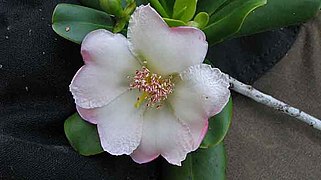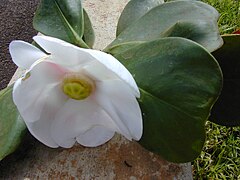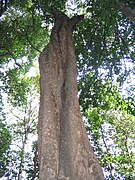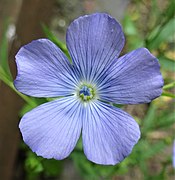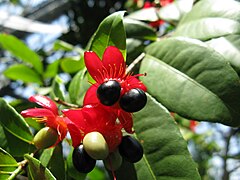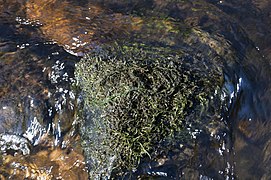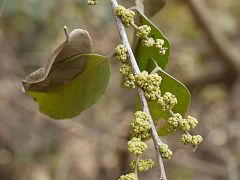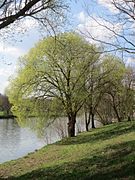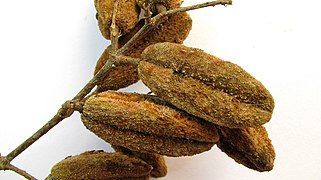Malpighiales
| Malpighiales Temporal range:
| |
|---|---|

| |
| Flower of Calophyllum inophyllum (Calophyllaceae) | |
| Scientific classification | |
| Kingdom: | Plantae |
| Clade: | Tracheophytes |
| Clade: | Angiosperms |
| Clade: | Eudicots |
| Clade: | Rosids |
| Clade: | Fabids
|
| Order: | Malpighiales Juss. ex Bercht. & J.Presl[1] |
| Type genus | |
| Malpighia | |
| Families | |
| |
| Synonyms | |
|
Rhizophorales | |
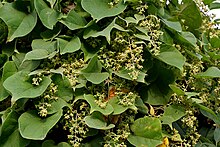
The Malpighiales comprise one of the largest
The Malpighiales are divided into 32 to 42
In a 2009
Some examples of notable species include
Affinities
Malpighiales is a member of a
Some recent studies have placed Malpighiales as sister to Oxalidales
The COM clade is part of an
History
The French botanist Charles Plumier named the genus Malpighia in honor of Marcello Malpighi's work on plants; Malpighia is the type genus for the Malpighiaceae, a family of tropical and subtropical flowering plants.
The family Malpighiaceae was the
The taxon was largely presaged by
The
Circumscription
Malpighiales is
The genera Cyrillopsis (Ixonanthaceae), Centroplacus (Centroplacaceae), Bhesa (Centroplacaceae), Aneulophus (Erythroxylaceae), Ploiarium (Bonnetiaceae), Trichostephanus (Samydaceae), Sapria (Rafflesiaceae), Rhizanthes (Rafflesiaceae), and Rafflesia (Rafflesiaceae) had been either added or confirmed as members of Malpighiales by the end of 2009.[5]
Some family delimitations have changed, as well, most notably, the
The group is difficult to characterize phenotypically, due to sheer morphological diversity, ranging from tropical holoparasites with giant flowers and temperate trees and herbs with tiny, simple flowers.[2] Members often have dentate leaves, with the teeth having a single vein running into a congested and often deciduous apex (i.e., violoid, salicoid, or theoid).[22] Also, zeylanol has recently been discovered in Balanops and Dichapetalum [23] which are in the balanops clade (so-called Chrysobalanaceae s. l.). The so-called parietal suborder (the clusioid clade and Ochnaceae s. l. were also part of Parietales) corresponds with the traditional Violales as 8 (Achariaceae, Violaceae, Flacourtiaceae, Lacistemataceae, Scyphostegiaceae, Turneraceae, Malesherbiaceae, and Passifloraceae) of the order's 10 families along with Salicaceae, which have usually been assigned as a related order or suborder,[24] are in this most derived malpighian suborder, so that eight of the 10 families of this suborder are Violales. The family Flacourtiaceae has proven to be polyphyletic as the cyanogenic members have been placed in Achariaceae and the ones with salicoid teeth were transferred to Salicaceae.[22] Scyphostegiaceae, consisting of the single genus Scyphostegia has been merged into Salicaceae.[25]
Phylogeny
2009
The phylogeny of Malpighiales is, at its deepest level, an unresolved polytomy of 16 clades.[2] It has been estimated that complete resolution of the phylogeny will require at least 25000 base pairs of DNA sequence data per taxon.[26] A similar situation exists with Lamiales and it has been analyzed in some detail.[27] The phylogenetic tree shown below is from Wurdack and Davis (2009). The statistical support for each branch is 100% bootstrap percentage and 100% posterior probability, except where labeled, with bootstrap percentage followed by posterior probability.
| Malpighiales |
| ||||||||||||||||||||||||||||||||||||||||||||||||||||||||||||||||||||||||||||||||||||||||||||||||||||||||||||||||||||||||||||||||||||||||||||||||
2012
In 2012, Xi et al. managed to obtain a more resolved phylogenetic tree than previous studies through the use of data from a large number of genes. They included analyses of 82 plastid genes from 58 species (they ignored the problematic
| |||||||||||||||||||||||||||||||||||||||||||||||||||||||||||||||||||||||||||||||||||||||||||||||||||||||||||||||||||||||||||||||||||||||||||||||||||||||||||||
Changes made in the Angiosperm Phylogeny Group (APG) classification of 2016 (APG IV) were the inclusion of Irvingiaceae, Peraceae, Euphorbiaceae and Ixonanthaceae, together with the transfer of the COM clade from the fabids (rosid I) to the malvids (rosid II).[12]
Gallery of type genera
-
Acharia tragodes (chaulmoogra family)
-
Balanops australiana (pimplebark family)
-
Bonnetia stricta (cascarilla family)
-
Calophyllum brasiliense (takamaka family)
-
Caryocar brasiliense (souari-tree family)
-
Centroplacus glaucinus(biku-biku family)
-
Chrysobalanus icaco (cocoplum family)
-
Clusia rosea (mangosteen family)
-
Dichapetalum gelonioides (ratbane family)
-
Elatine hydropiper (waterwort family)
-
Erythroxylum coca (coca family)
-
Euphorbia antiquorum (spurge family)
-
Euphronia hirtelloides (euphronia family)
-
Goupia glabra (kopi family)
-
Humiria balsamifera (umiri family)
-
Hypericum canariense (St.-John's-wort family)
-
Irvingia smithii (ogbono-nut family)
-
Ixonanthes reticulata (twentymen-tree family)
-
Lacistema hasslerianum (cemp-wood family)
-
Linum usitatissimum(flax family)
-
Malpighia glabra (acerola family)
-
Ochna thomasiana (Mickey-Mouse-plant family)
-
Panda oleosa (kana-nut family)
-
Passiflora incarnata (passionfruit family)
-
Pera glabrata (lightning-bush family)
-
Phyllanthus niruri (leafflower family)
-
Petalostigma pubescens (hollyspurge family; type genus Picrodendron not shown)
-
Podostemum ceratophyllum (riverweed family)
-
Putranjiva roxburghii (childlife-tree family)
-
Rafflesia Arnoldii (corpse-flower family)
-
Rhizophora mangle (mangrove family)
-
Salix alba (willow family)
-
Trigonia nivea (triangle-vine family)
-
Tristellateia australasiae (Malpighiaceae family)
-
Viola odorata (violet family)
"Litoh family" is a
References
- ^ hdl:10654/18083.
- ^ a b c d e Endress et al 2013.
- ^ a b c Stevens 2020.
- ^ PMID 21628193
- ^ S2CID 23284896
- ^ Alan Radcliffe-Smith. 2001. Genera Euphorbiacearum. Royal Botanic Gardens, Kew: Richmond, England.
- ISBN 978-0-87893-817-9
- ^ PMID 19223592
- ^ Alexander B. Doweld. 2001. Prosyllabus Tracheophytorum. Tentamen systematis plantarum vascularium (Tracheophyta). Geos: Moscow, Russia.
- S2CID 86095495
- PMID 19292928
- ^ a b APG IV 2016.
- JSTOR 25065865, archived from the original(PDF) on 11 July 2021, retrieved 11 September 2009
- ^ Antoine Laurent de Jussieu (1789), Genera Plantarum, Paris: Herrisant and Barrois, p. 252
- ^ James L. Reveal (2008), "A Checklist of Family and Suprafamilial Names for Extant Vascular Plants", Home page of James L Reveal and C. Rose Broome, archived from the original on 20 January 2016, retrieved 11 September 2009
- ^ John Hutchinson The Families of Flowering Plants 3rd edition. 1973. Oxford University Press.
- ^ Lawrence, George. 1960. Taxonomy of Vascular Plants, p. 132. Macmillan, New York
- ^ Mark W. Chase et alii (42 authors). 1993. "Phylogenetics of seed plants: An analysis of nucleotide sequences from the plastid gene rbcL". Annals of the Missouri Botanical Garden 80(3):528-580.
- ]
- ^ Soltis, Douglas E.; Clayton, Joshua W.; Davis, Charles C.; Gitzendanner, Matthew A.; Cheek, Martin; Savolainen, Vincent; Amorim, André M.; Soltis, Pamela S. (2007). "Monophyly and relationships of the enigmatic family Peridiscaceae". Taxon. 56 (1): 65–73.
- ^ Mac H. Alford. 2007. "Samydaceae Archived 3 August 2020 at the Wayback Machine". Version 6 February 2007". In: The Tree of Life Web Project.
- ^ PMID 21652313.
- ^ Darbah, V. F.; Oppong, E. K.; Eminah, J. K. (2012). "Chemical investigation of the stem bark of Dichapetalum magascariennse Poir". International Journal of Applied Chemistry. 8 (3): 199–207.
- ^ Brummitt, 1992. Vascular Plant Families and Genera. Kew.
- ^ Christenhusz et al 2017.
- PMID 18275001
- PMID 16195214.
- ^ Catalogue of Organisms: Malpighiales: A Glorious Mess of Flowering Plants
- PMID 23045684.
- ISBN 978-0-226-52292-0.
Bibliography
- ISBN 978-0-226-52292-0.
- .
- Cai, Liming; Xi, Zhenxiang; Amorim, André M.; Sugumaran, M.; Rest, Joshua S.; Liu, Liang; Davis, Charles C. (January 2019). "Widespread ancient whole-genome duplications in Malpighiales coincide with Eocene global climatic upheaval". PMID 30030969.
- Endress, Peter K.; Davis, Charles C.; Matthews, Merran L. (May 2013). "Advances in the floral structural characterization of the major subclades of Malpighiales, one of the largest orders of flowering plants". PMID 23486341.
- Cole, Theodor C H (2018). "Malpighiales Phylogeny Poster". Retrieved 27 April 2020.
- Stevens, P.F. (2020) [2001]. "Malpighiales". AP Web v. 14. Missouri Botanical Garden. Retrieved 28 April 2020. (see also Angiosperm Phylogeny Website)



